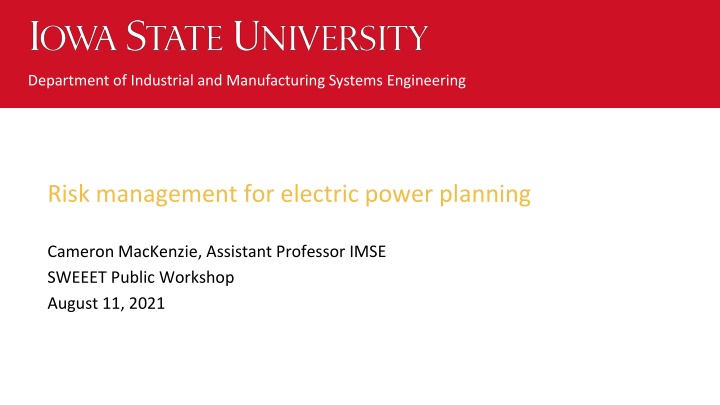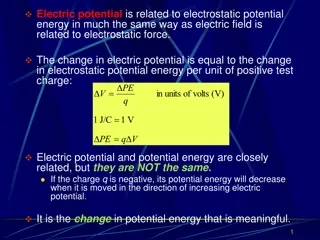
Risk Management for Electric Power Planning
This content discusses risk management in electric power planning, including fire hazards, safety risks, market changes, cyber attacks, and more. It also emphasizes the importance of safety culture, design principles, and operational procedures in industrial and manufacturing systems engineering. Additionally, it explores strategies for enhancing electrical supply and reliability, safety training, business continuity planning, and other key considerations in the industry.
Download Presentation

Please find below an Image/Link to download the presentation.
The content on the website is provided AS IS for your information and personal use only. It may not be sold, licensed, or shared on other websites without obtaining consent from the author. If you encounter any issues during the download, it is possible that the publisher has removed the file from their server.
You are allowed to download the files provided on this website for personal or commercial use, subject to the condition that they are used lawfully. All files are the property of their respective owners.
The content on the website is provided AS IS for your information and personal use only. It may not be sold, licensed, or shared on other websites without obtaining consent from the author.
E N D
Presentation Transcript
Department of Industrial and Manufacturing Systems Engineering Risk management for electric power planning Cameron MacKenzie, Assistant Professor IMSE SWEEET Public Workshop August 11, 2021
Risks Fire and explosion hazards Safety risks Distributed power generation Market changes Industrial Internet of Things Cyber attacks Regulatory changes Natural hazards and global warming Supply chain and business continuity risks 2 Industrial and Manufacturing Systems Engineering
People problem Corporate leaders to make safety part of their value structure by initiating and driving a culture of safety throughout the organization. Engineers to apply inherently safe design principles. Maintenance engineers to verify isolations while reliability engineers maintain asset uptime. Operators to start up, shut down and respond to abnormal conditions. Procurers, suppliers and transporters to understand their contribution to delivering and managing quality spare parts, materials and services that prevent the loss of containment 3 Industrial and Manufacturing Systems Engineering
What can be done? Electrical supply and reliability Electrical safety and training Business continuity planning Fire protection engineering Natural hazards engineering Smart factories Accurate property values Insurance 4 Industrial and Manufacturing Systems Engineering
When planners in an electric power company need to add new generating capacity, they may consider building a plant that burns coal or natural gas. After all, such fossil fuel fired facilities are relatively inexpensive and should run for 40 years or more. But if future policies impose strict limits on carbon emissions, they might need to shut down their fossil fuel plants and build non-carbon systems such as solar or wind in a hurry two extremely expensive propositions. On the other hand, if they build the more expensive non-carbon systems now and emissions policies aren t enacted, they may have spent that extra money unnecessarily. Deciding to build fossil plants or choosing to invest in non-carbon generation either decision has economic risk, given the uncertainty about long-term emissions policy. 5 Industrial and Manufacturing Systems Engineering
On that basis, we believe there is a strong case for utilities to start now to take steps on climate-change adaptation. And there are ways for them to do so for example by strengthening the grid, exploring investments in batteries and microgrids, and working with new partners. 6 Industrial and Manufacturing Systems Engineering
Risks Global warming and climate change Rapidly changing industry Cyber threats Regulation and public policy Tariffs and trade tension Talent retention and new hires Catastrophic events 7 Industrial and Manufacturing Systems Engineering
8 Industrial and Manufacturing Systems Engineering
Actions Harden the grid Explore nonwire options that go beyond hardening the grid Decentralizing generation Battery storage Microgrids Environmental management Factor an up-to-date view of risk of operations Look for new partners to develop resilient strategies 9 Industrial and Manufacturing Systems Engineering
Previous sessions assumed public or market risks Based on option theory in financing Assumption that all risk can be mitigated by hedging 10 Industrial and Manufacturing Systems Engineering
Example (from previous session) Cost paid by BUS 1 $7.92 * 270MW * 8760 hrs = $18.732 million Demand = 270 p Demand = 200 1 - p Cost paid by BUS 1 $7.85 * 148MW * 8760 hrs = $10.178 million Demand = 148 11 Industrial and Manufacturing Systems Engineering
Hedge the risk: Purchase futures on price of energy (assume future price = LMP) Calculate X with assumption that cash flow is the same whether price = $7.92 or $7.85 Revenue $7.92 * X Price = $7.92 p $7.92X - $18.732 mil = $7.85X - $10.178 mil Demand = 200 X = 122.2 million Whether future price is $7.92 or $7.85, cash flow in year 1 is $949 mil 1 - p Revenue $7.85 * X Price = $7.85 Park, C. S. (2016). Contemporary Engineering Economics, 6th edition, Hoboken, NJ: Pearson Higher Education. 12 Industrial and Manufacturing Systems Engineering
No uncertainty = no risk! Use risk-free interest rate (in our example 4.879%) Under these assumptions, any decision maker (risk neutral, risk averse, risk seeking) would have the same value for a real option Probability of demand increasing or decreasing is irrelevant in the problem Use risk-neutral probability for expected value calculations (in our example 0.5077 probability of demand increase) Risk-neutral probability does not really represent chance of demand increasing or decreasing 13 Industrial and Manufacturing Systems Engineering
Risks for power producers and municipal utilities 14 Industrial and Manufacturing Systems Engineering
Risk assessment answers 3 questions What can go wrong? 1. What are the chances of it going wrong? 2. What are the consequences if it does go wrong? 3. 15 Industrial and Manufacturing Systems Engineering
Uncertainties in future electricity planning Efficiency and capacity of renewable energy sources Regulations especially capacity limits on coal and natural gas Global warming and climate change Rapidly changing industry Cyber threats Talent retention and new hires Catastrophic events 16 Industrial and Manufacturing Systems Engineering
What can be done to manage or mitigate the risks 17 Industrial and Manufacturing Systems Engineering
Actions to mitigate risk Harden the grid Explore nonwire options that go beyond hardening the grid Decentralizing generation Battery storage Microgrids Environmental management Factor an up-to-date view of risk of operations Look for new partners to develop resilient strategies 18 Industrial and Manufacturing Systems Engineering
Design for reliability and resilience How to design a system to increase its reliability and resilience? Redundancy Hardness Recovery Restoration 19 Industrial and Manufacturing Systems Engineering
How to think about whether to engage in risk mitigation? Assess risk by answering 3 questions 1. Assess probabilities (can be very difficult!) Translate consequences to metrics (e.g., dollars lost) Calculate consequences without risk mitigation Calculate consequences with mitigation Conduct risk-cost analysis to analyze Risk neutral decision maker Risk averse decision maker 2. 3. 4. 20 Industrial and Manufacturing Systems Engineering
Uncertain deal Imagine that your organization is offered the following $1 million 0.5 0.5 -$1 million Would your organization take the deal? 21 Industrial and Manufacturing Systems Engineering
Uncertain deal Imagine that your organization is offered the following $1 million 0.95 0.05 -$1 million Would your organization take the deal? 22 Industrial and Manufacturing Systems Engineering
Indifference point $1 million p $0 ~ 1-p -$1 million What is the value of p that makes your organization indifferent? Different p different risk attitudes 23 Industrial and Manufacturing Systems Engineering
Risk attitude Prefer gamble risk seeking Prefer sure thing risk averse $1 million 0.5 $0 Expected value = $0 OR 0.5 -$1 million Indifferent risk neutral 24 Industrial and Manufacturing Systems Engineering
Example (assume risk of demand cannot be hedged) Demand = 270 Cost paid by BUS 1 $7.92 * 270MW * 8760 hrs = $18.732 million 0.7 Add power source G1 0.3 Demand = 148 Cost paid by BUS 1 $7.85 * 148MW * 8760 hrs = $10.178 million Demand = 270 Cost paid by BUS 1 $8.045 * 270MW * 8760 hrs = $19.028 million Don t add power source G1 0.7 0.3 Demand = 148 Cost paid by BUS 1 $7.85 * 148MW * 8760 hrs = $10.178 million 25 Industrial and Manufacturing Systems Engineering
Value of installing power source at G1 Expected (average) cost with power source at G1 = [$18.732*0.7 + 10.178*0.3] / 1.05 = $16.166 million / 1.05 = $15.396 million Note: exp(.0498*1) = 1.05 is the risk-free interest rate for 1 year Expected (average) cost without power source at G1 = [$19.028*0.7 + 10.178*0.3] / 1.05 = $16.373 million / 1.05 = $15.593 million Value of installing power source at G1 = $15.593 15.396 = $0.197 million Only install power source if cost of power source less than $197,000 26 Industrial and Manufacturing Systems Engineering
Risk tolerance Find your organization s risk tolerance $1 million p $0 ~ 1-p -$1 million 1 Risk tolerance (in millions of dollars) = ? ln 1 ? 27 Industrial and Manufacturing Systems Engineering
Risk-averse utility function 28 Industrial and Manufacturing Systems Engineering
Exponential utility function U(x) = 1 exp(-x / risk tolerance) Example with profit or revenue Risk tolerance = $2 million Profit = $3 million U(3) = 1 exp(-3/2) = 0.777 Example with cost Risk tolerance = $2 million Cost = $10 million (treat cost as a negative number) U(-10) = 1 exp(10/2) = -147.413 29 Industrial and Manufacturing Systems Engineering
Example with risk aversion Demand = 270 U(-$18.732 million / 1.05) = -1384.06 0.7 Add power source G1 0.3 Demand = 148 U(-$10.178 million / 1.05) = -49.93 Demand = 270 U(-$19.028 million / 1.05) = -1551.78 Don t add power source G1 0.7 0.3 Demand = 148 U(-$10.178 million / 1.05) = -49.92 30 Industrial and Manufacturing Systems Engineering
Value of installing power source at G1 Expected (average) utility with power source at G1 = -1384.06*0.7 49.93*0.3 = -983.82 Expected (average) utility without power source at G1 = -1551.78*0.7 49.93*0.3 = -1101.22 Convert utilities back to dollars in cost using certain equivalence CE (-983.82) = 2.47 mil * ln(1 + 983.82) = $16.999 million CE (-1101.22) = 2.47 mil * ln(1 + 1101.22) = $17.277 million Value of installing power source at G1 = $17.277 16.999 = $0.277 million Install power source if cost of power source less than $277,000 31 Industrial and Manufacturing Systems Engineering
Insights from risk-averse decision making Most people are risk averse Avoid bad outcomes Willing to sacrifice chances of some good outcomes to reduce the chances of bad outcomes The more risk averse you or your organization is The more you should be willing to do now to protect against future risks The more you should be willing to spend now to avoid potential bad outcomes An organization should not be so risk averse it forgoes good opportunities 32 Industrial and Manufacturing Systems Engineering
Choosing among alternatives (risk-benefit trade-off) Risk-seeking Measure of the benefits Risk-neutral Risk-averse Probability of failure Variance Risk 33 Industrial and Manufacturing Systems Engineering
Risk-cost curve Risk-seeking Risk Risk-neutral Risk-averse Cost of risk mitigation 34 Industrial and Manufacturing Systems Engineering
Design for reliability and resilience What is the optimal level of resilience for a system? Optimum solution 35 Industrial and Manufacturing Systems Engineering
Can all risk be hedged in the market? Integrated valuation procedure (Smith and Nau 1995, Smith and McCardle 1998) If a risk is a market or public risk (i.e., can be perfectly hedged in the market) use risk-neutral probabilities and risk-free rate to calculate value of options If a risk is a private risk that cannot be hedged in the market (e.g., uncertainties about production) use subjective probabilities and Risk-free rate and expected NPV if decision maker is risk neutral Risk-averse utility function if decision maker is risk averse Smith, J. E. & Nau, R. F. (1995). Valuing risky projects: Option pricing theory and decision analysis. Management Science 41(5): 795-816. Smith, J. E. & McCardle, K. F. (1998). Valuing oil properties: Integrating option pricing and decision analysis approaches. Operations Research 46(2): 198-217. 36 Industrial and Manufacturing Systems Engineering






















